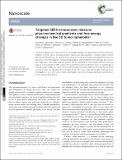Files in this item
Targeted SERS nanosensors measure physicochemical gradients and free energy changes in live 3D tumor spheroids
Item metadata
| dc.contributor.author | Jamieson, Lauren E. | |
| dc.contributor.author | Camus, Victoria L. | |
| dc.contributor.author | Bagnaninchi, Pierre O. | |
| dc.contributor.author | Fisher, Kate M. | |
| dc.contributor.author | Stewart, Grant D. | |
| dc.contributor.author | Nailon, William H. | |
| dc.contributor.author | McLaren, Duncan B. | |
| dc.contributor.author | Harrison, David James | |
| dc.contributor.author | Campbell, Colin J. | |
| dc.date.accessioned | 2016-09-14T15:30:23Z | |
| dc.date.available | 2016-09-14T15:30:23Z | |
| dc.date.issued | 2016-10-07 | |
| dc.identifier | 245601332 | |
| dc.identifier | db1fc12e-d696-4cde-9aa1-467e5c4ca227 | |
| dc.identifier | 84988732016 | |
| dc.identifier | 000387857700016 | |
| dc.identifier.citation | Jamieson , L E , Camus , V L , Bagnaninchi , P O , Fisher , K M , Stewart , G D , Nailon , W H , McLaren , D B , Harrison , D J & Campbell , C J 2016 , ' Targeted SERS nanosensors measure physicochemical gradients and free energy changes in live 3D tumor spheroids ' , Nanoscale , vol. 8 , no. 37 , pp. 16710-16718 . https://doi.org/10.1039/C6NR06031E | en |
| dc.identifier.issn | 2040-3364 | |
| dc.identifier.other | ORCID: /0000-0001-9041-9988/work/64034353 | |
| dc.identifier.uri | https://hdl.handle.net/10023/9500 | |
| dc.description | CJC is grateful to the Leverhulme trust for support (Project Grant RPG-2012-680). VLC is grateful to the Jamie King Cancer Research Fund for funding. | en |
| dc.description.abstract | Use of multicellular tumor spheroids (MTS) to investigate therapies has gained impetus because they have potential to mimic factors including zonation, hypoxia and drug-resistance. However, analysis remains difficult and often destroys 3D integrity. Here we report an optical technique using targeted nanosensors that allows in situ 3D mapping of redox potential gradients whilst retaining MTS morphology and function. The magnitude of the redox potential gradient can be quantified as a free energy difference (ΔG) and used as a measurement of MTS viability. We found that by delivering different doses of radiotherapy to MTS we could correlate loss of ΔG with increasing therapeutic dose. In addition, we found that resistance to drug therapy was indicated by an increase in ΔG. This robust and reproducible technique allows interrogation of an in vitro tumor-model's bioenergetic response to therapy, indicating its potential as a tool for therapy development. | |
| dc.format.extent | 9 | |
| dc.format.extent | 2871684 | |
| dc.language.iso | eng | |
| dc.relation.ispartof | Nanoscale | en |
| dc.subject | Nanosensor | en |
| dc.subject | SERS | en |
| dc.subject | Spheroid | en |
| dc.subject | Redox | en |
| dc.subject | Free-energy | en |
| dc.subject | RC0254 Neoplasms. Tumors. Oncology (including Cancer) | en |
| dc.subject | RM Therapeutics. Pharmacology | en |
| dc.subject | T Technology | en |
| dc.subject | NDAS | en |
| dc.subject | BDC | en |
| dc.subject | R2C | en |
| dc.subject | SDG 3 - Good Health and Well-being | en |
| dc.subject.lcc | RC0254 | en |
| dc.subject.lcc | RM | en |
| dc.subject.lcc | T | en |
| dc.title | Targeted SERS nanosensors measure physicochemical gradients and free energy changes in live 3D tumor spheroids | en |
| dc.type | Journal article | en |
| dc.contributor.institution | University of St Andrews. School of Medicine | en |
| dc.identifier.doi | https://doi.org/10.1039/C6NR06031E | |
| dc.description.status | Peer reviewed | en |
This item appears in the following Collection(s)
Items in the St Andrews Research Repository are protected by copyright, with all rights reserved, unless otherwise indicated.

